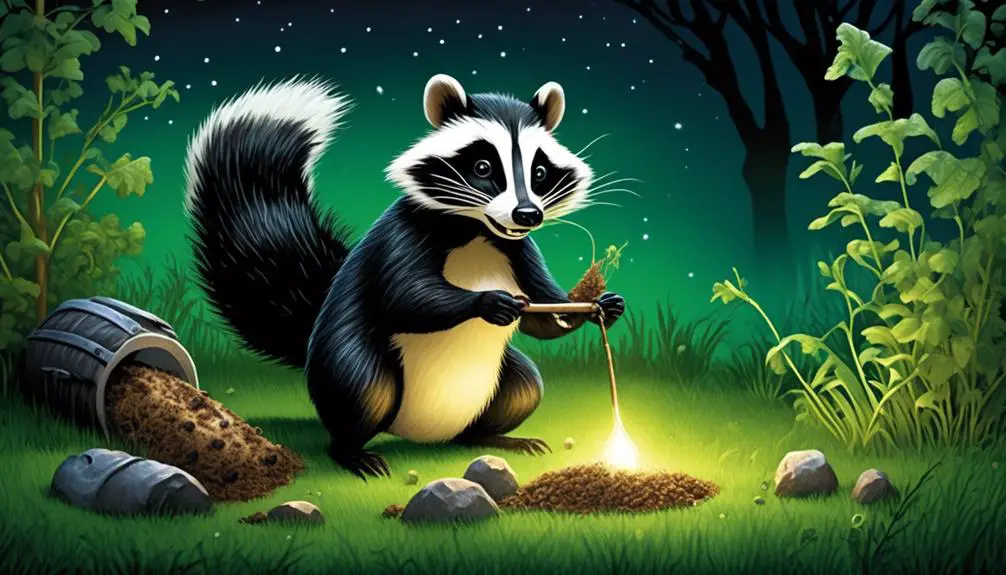Are you tired of watching your once pristine lawn become a battleground for pesky pests? It’s time to uncover the secret behind those mysterious holes and damaged patches.
Enter the world of opossums, skunks, gophers, raccoons, and squirrels – the culprits with an insatiable appetite for lawn grubs. But what drives these creatures to search for these delectable treats? How do they locate and devour them? And perhaps most importantly, what impact do they have on your beloved outdoor space?
Brace yourself for an exploration into the fascinating lives of these animals and their unyielding desire for grubs. Get ready to uncover the hidden truths and discover how to protect your garden from their destructive ways.
Opossums and Skunks
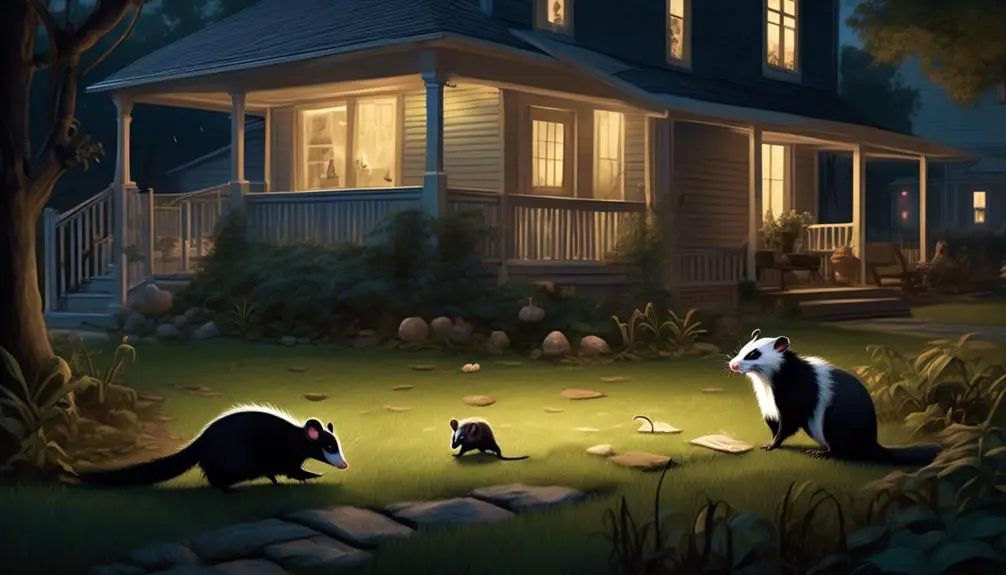
Opossums and skunks are two nocturnal creatures that have a fondness for grubs, using different methods to locate and consume these tasty morsels.
Opossums, with their delicate feet and nails, don’t dig large holes like other animals. Instead, they may dig small holes in soft turf to search for grubs. However, opossums try to avoid digging up lawns for food unless they’re desperate.
On the other hand, skunks are omnivorous creatures that eat a variety of food. They rely on their sense of smell to find food since their eyesight is poor. When it comes to grubs, skunks dig holes in the ground to search for earthworms and grubs.
Both opossums and skunks find insect grubs to be a readily available delicacy. Grubs provide a nutritious meal for these animals. However, it’s important to note that while opossums may eat grubs when they come across them, grubs are a preferred choice for skunks. Skunks actively seek out grubs by digging holes in the ground, using their keen sense of smell to locate these delectable treats.
The high protein content of grubs makes them an appealing food source for both opossums and skunks.
Gophers
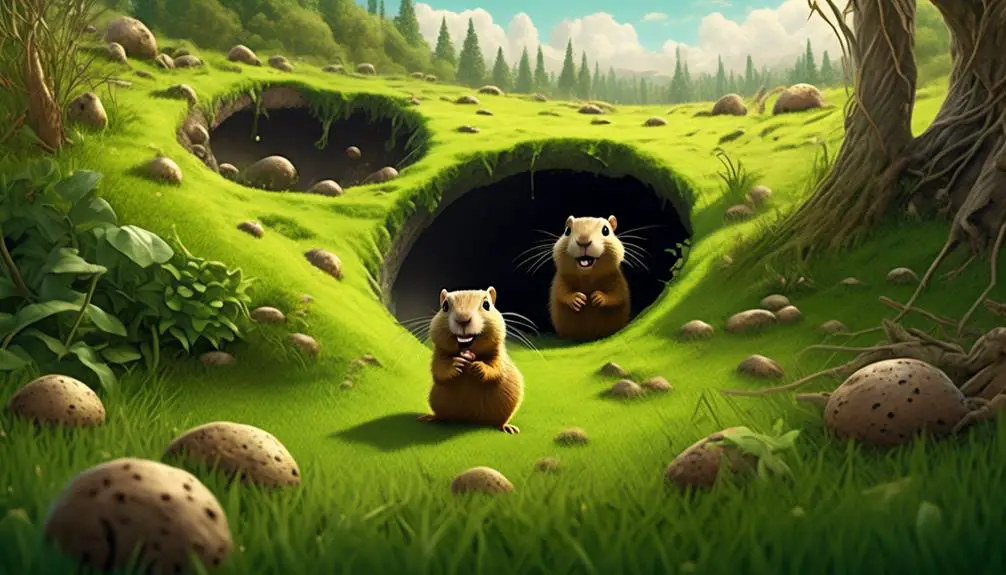
Skunks and opossums may not be the only animals fond of grubs, as gophers also have a taste for these subterranean delicacies. Gophers, known for their burrowing skills, aren’t too picky about their food choices. They create intricate tunnels underground to locate and eat their preferred food, including insect grubs. These tunnels provide easy access to earthworms and grubs near the soil surface.
Gophers, like skunks and opossums, have a keen sense of smell that helps them locate their food. They rely on their olfactory senses to detect the presence of grubs, which they consider a delectable treat. Once they find a grub, they quickly consume it, relishing the protein-rich morsel.
Unlike skunks and opossums, gophers primarily feed on grubs as part of their regular diet. They’ve a voracious appetite for earthworms and insect grubs, which they find abundant in lawns and gardens. This can lead to damage in turf areas, as gophers dig extensive tunnels to search for their favorite food.
Raccoons
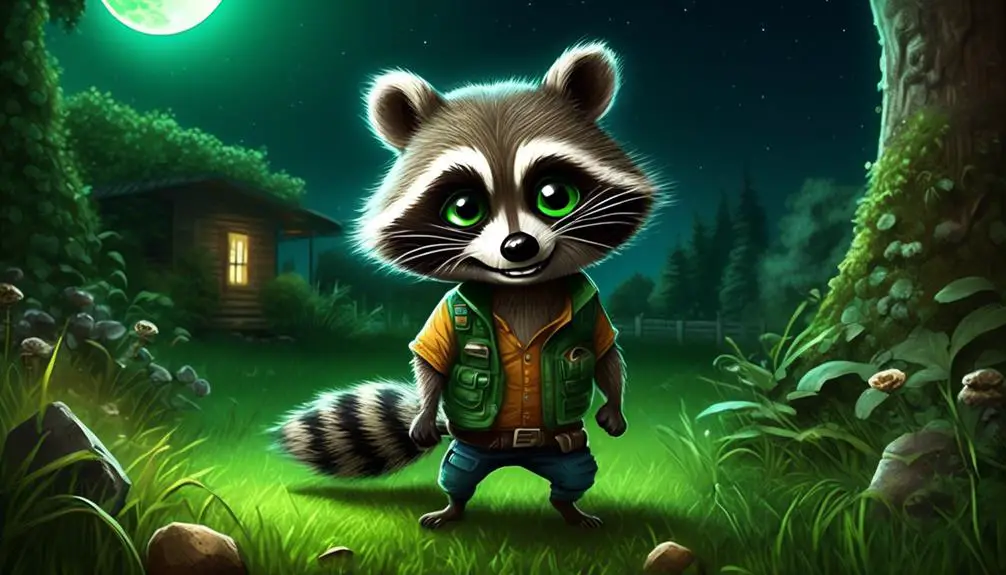
Raccoons, with their affinity for grubs, can be a cause of concern for gardens and lawns. These curious creatures have a knack for finding grubs hidden beneath the soil and aren’t afraid to dig up lawns in search of these tasty morsels. Raccoons are known for their dexterity and intelligence, which allows them to easily locate and extract grubs from the ground.
When hunting for grubs, raccoons use their keen sense of smell to detect the presence of these insects. They’ll then use their nimble paws to dig into the soil and expose the grubs. Once they’ve located a grub, raccoons will quickly devour it, savoring the high protein content that these insects provide.
Unfortunately, this love for grubs can result in damage to gardens and lawns. Raccoons will often return to the same area to search for more grubs, causing repeated disturbances to the turf. This can lead to unsightly patches and uprooted plants.
To prevent damage caused by raccoons and other pests, it’s important to remove grubs from your lawn. By eliminating their food source, you can discourage raccoons from frequenting your garden. Consider using natural methods, such as beneficial nematodes or milky spore, to control the grub population and protect your precious plants.
Squirrels
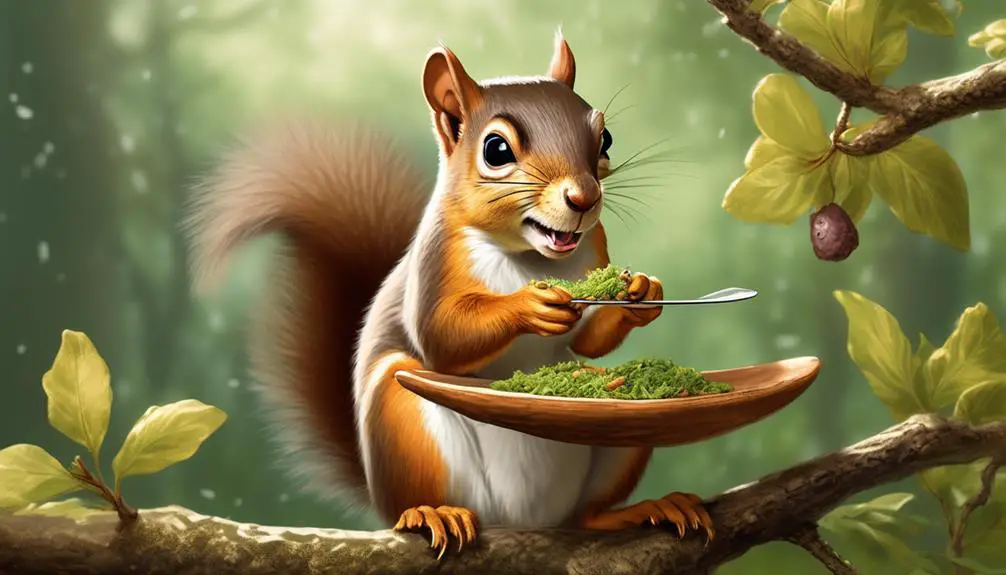
Squirrels, known for their resourcefulness and ability to find food even in challenging conditions, play a role in the consumption of lawn grubs. While grubs may not be their first choice, squirrels include them in their menu, especially during difficult times. Grubs provide a valuable supplement for squirrels, thanks to their high protein content. To convey a deeper understanding of the relationship between squirrels and grubs, let’s take a closer look at their preferences:
| Squirrels | Grubs |
|---|---|
| Omnivorous | Nutritious food source |
| Prefer nuts and seeds | High protein content |
| Consume a variety of foods | Serve as a supplement |
| Store more food than they need | Valuable during scarcity |
As omnivorous creatures, squirrels have a diverse diet, with nuts and seeds being their preferred choice. However, they also consume a variety of other foods, including grubs. Squirrels are known to store more food than they need, allowing them to have a surplus during times when food is scarce. Grubs, with their high protein content, serve as a valuable supplement for squirrels, providing essential nutrients. Although grubs may not be the first choice for squirrels, they play a role in their diet and contribute to their overall well-being.
Delicate Feet and Nails
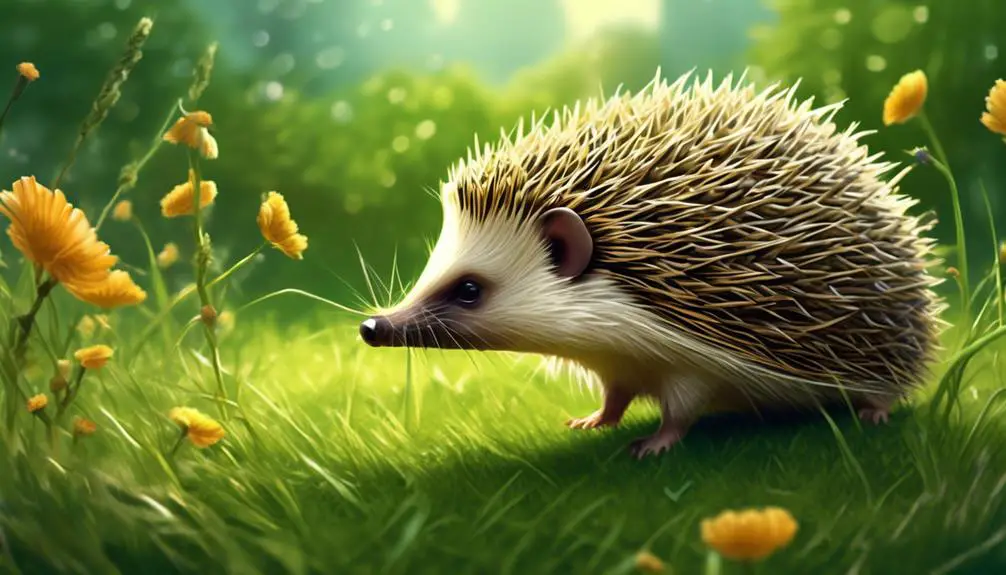
With their delicate feet and nails, these animals possess a cautious approach when it comes to searching for grubs in lawns. Opossums, skunks, gophers, raccoons, and squirrels all have different methods of finding and consuming grubs.
Opossums, known for their delicate feet, try to avoid digging up lawns for food unless desperate. They may dig small holes in soft turf to search for grubs.
Skunks, with their poor eyesight, rely on their sense of smell to find food. They dig holes in the ground to search for earthworms and grubs.
Gophers create tunnels underground to locate and eat their preferred food. These tunnels provide easy access to earthworms and grubs near the soil surface.
Raccoons, on the other hand, love to eat grubs and can cause damage to gardens and lawns. They’ll ransack turf to find grubs and keep coming back for more.
Squirrels, with their ability to find food even beneath a foot of snow, include grubs in their menu, although they aren’t their first choice. Grubs serve as a supplement for squirrels, especially during difficult times.
Small Holes in Soft Turf
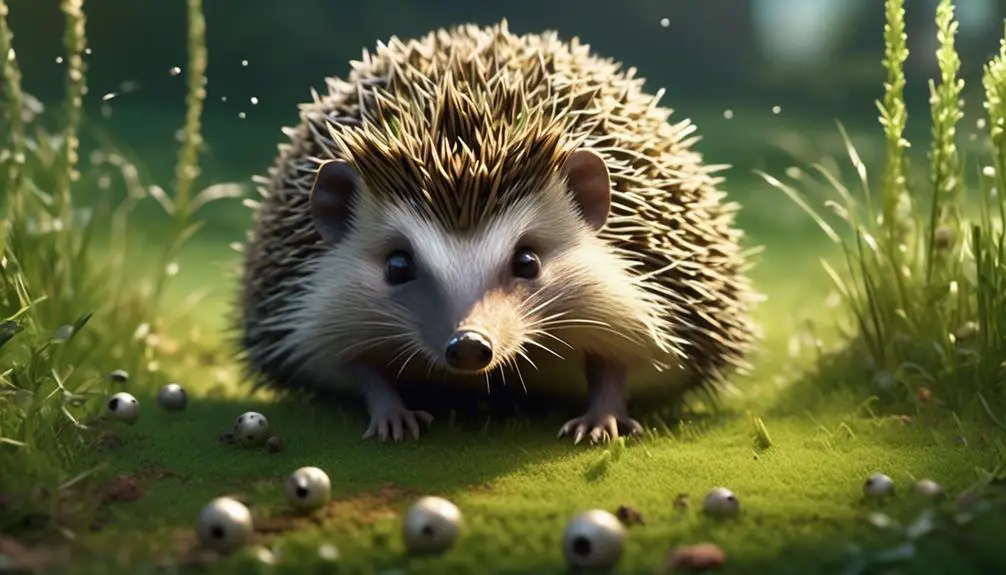
You notice small holes in your soft turf, and wonder what could be causing them.
These holes are likely the result of animals searching for insects, such as grubs, that live beneath the surface.
Animals like opossums, skunks, and raccoons have delicate feet and nails, so they dig small holes in the turf to access their food source.
Digging for Insects
Animals such as opossums, skunks, gophers, raccoons, and squirrels can be observed digging small holes in soft turf as they search for insects, including grubs.
Opossums have delicate feet and nails, so they don’t dig large holes. However, when desperate, they may dig small holes to find grubs.
Skunks, on the other hand, rely on their sense of smell to locate their preferred food, such as earthworms and grubs.
Gophers create tunnels underground to easily access earthworms and grubs near the soil surface.
Raccoons, known for their love of grubs, can cause damage to gardens and lawns as they search for their favorite delicacy.
Squirrels, although not their first choice, also include grubs in their diet due to their high protein content.
These animals demonstrate different techniques for finding and consuming grubs, emphasizing the importance of removing grubs to prevent damage to lawns and gardens.
Delicate Feet and Nails
As we continue exploring the fascinating world of animals that eat lawn grubs, let’s now shift our focus to the delicate feet and nails of these creatures and the small holes they create in soft turf.
| Animals | Feet and Nails | Small Holes in Soft Turf |
|---|---|---|
| Opossums | Delicate feet and nails of opossums make them cautious diggers. They may create small holes in soft turf to search for grubs. Opossums try to avoid digging up lawns for food unless desperate. | Opossums may leave small holes in soft turf when searching for grubs. |
| Skunks | Skunks have omnivorous diets and eat a variety of food. They dig holes in the ground to search for earthworms and grubs. Skunks rely on their sense of smell to find food. | Skunks may create small holes in soft turf while searching for grubs. |
| Gophers | Gophers eat a variety of food, including insect grubs. They create tunnels underground to locate and eat their preferred food. | Gophers may create tunnels underground, providing easy access to grubs near the soil surface. |
| Raccoons | Raccoons love to eat grubs and can cause damage to gardens and lawns. They search for grubs and return home after a good meal. | Raccoons may ransack turf in search of grubs, leaving small holes behind. |
| Squirrels | Squirrels can find food even beneath a foot of snow. They store more food than they need and have an appetite for grubs. | Squirrels include grubs in their diet, although they are not their first choice. |
These animals, with their delicate feet and nails, create small holes in soft turf as they search for grubs. Opossums and skunks may leave behind small holes while looking for their preferred delicacy. Gophers, on the other hand, create tunnels underground to locate and eat grubs near the soil surface. Raccoons, known for their love of grubs, may ransack turf in search of these tasty treats, resulting in small holes in the process. Squirrels, with their impressive foraging skills, include grubs in their diet, although they prioritize other food sources. Understanding the impact of these animals’ delicate feet and nails helps us appreciate their unique feeding habits and the small holes they leave behind in soft turf.
Turf Damage Prevention
To prevent damage to your turf caused by the small holes created by animals searching for grubs, a proactive approach is necessary. These holes can disrupt the aesthetic appeal of your lawn and create a haven for weeds to take root.
One effective method to prevent such damage is by addressing the grub population in your lawn. Removing grubs can significantly reduce the attraction for animals like opossums, skunks, gophers, raccoons, and squirrels. Consider using organic grub control products or employing natural methods, such as nematodes or milky spore, to target these pests.
Additionally, maintaining a healthy lawn through proper watering, mowing, and fertilizing practices can make it less attractive to grubs and the animals that feed on them.
Omnivorous Creatures
Omnivorous creatures, such as opossums, skunks, gophers, raccoons, and squirrels, have a diverse diet that includes grubs as a valuable food source. These animals exhibit different behaviors when it comes to finding and consuming grubs.
Opossums, with their delicate feet and nails, prefer not to dig large holes in search of grubs. However, in soft turf, they may dig small holes to uncover these tasty treats. Opossums aren’t typically inclined to dig up lawns for food unless they’re desperate for sustenance.
Skunks, on the other hand, are known for their omnivorous nature. They eat a variety of food and have a keen sense of smell to locate their prey. Skunks dig holes in the ground to search for earthworms and grubs. With their poor eyesight, they rely heavily on their sense of smell to find their next meal. Insect grubs are a readily available delicacy for both opossums and skunks.
Gophers, although not as famous as opossums and skunks, also include grubs in their diet. These creatures create tunnels underground, providing easy access to earthworms and grubs near the soil surface. Gophers aren’t too picky about their food choices and enjoy a regular diet of earthworms and insect grubs.
Raccoons, with their notorious reputation for causing damage to gardens and lawns, love to eat grubs. They search diligently for grubs and will ransack turf in their pursuit. Raccoons find grubs to be a favorite delicacy and will keep coming back for more.
Lastly, squirrels, with their remarkable ability to find food even beneath a foot of snow, also have an appetite for grubs. Although not their first choice, squirrels include grubs in their menu. Grubs serve as a supplement, especially during difficult times, due to their high protein content.
Holes in the Ground
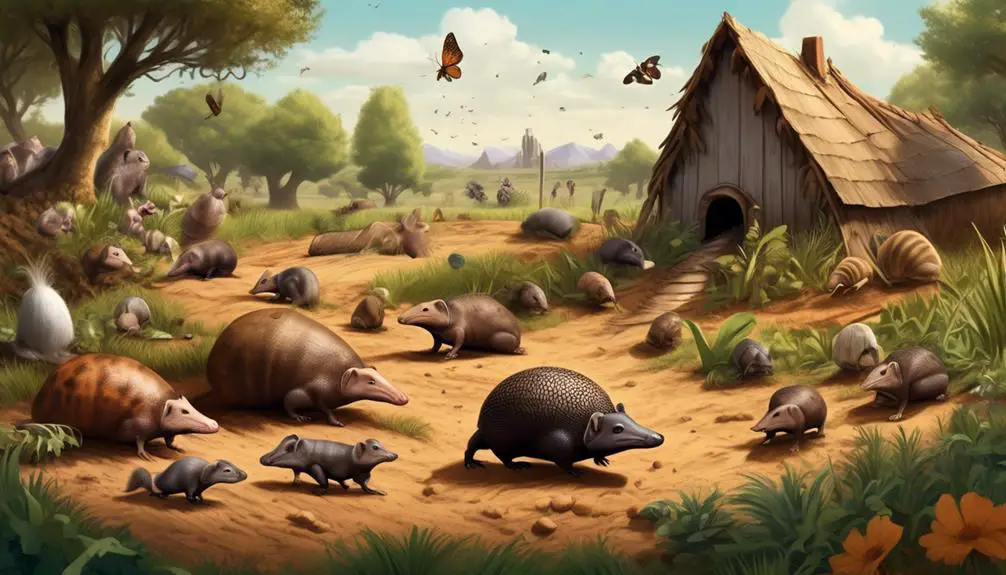
Holes in the ground serve as crucial access points for animals to find and consume their preferred food sources, including grubs. These holes are created by various animals, such as opossums, skunks, gophers, raccoons, and squirrels. Let’s take a closer look at how each of these animals utilizes holes in their search for grubs.
| Animal | Digging Behavior | Food Preference |
|---|---|---|
| Opossums | Small holes | Grubs |
| Skunks | Dig holes | Earthworms, grubs |
| Gophers | Tunneling | Earthworms, grubs |
| Raccoons | Ransack turf | Grubs |
| Squirrels | Not their first choice | Grubs |
Opossums have delicate feet and nails, so they don’t dig large holes. However, they may dig small holes in soft turf to search for grubs. Skunks, on the other hand, rely on their sense of smell to find food. They have poor eyesight and dig holes in the ground to search for earthworms and grubs. Gophers create tunnels underground to locate and eat their preferred food. These tunnels provide easy access to earthworms and grubs near the soil surface. Raccoons have a particular fondness for grubs and will ransack turf to find them. Lastly, squirrels, although grubs are not their first choice, include them in their menu due to their high protein content.
Poor Eyesight, Strong Sense of Smell
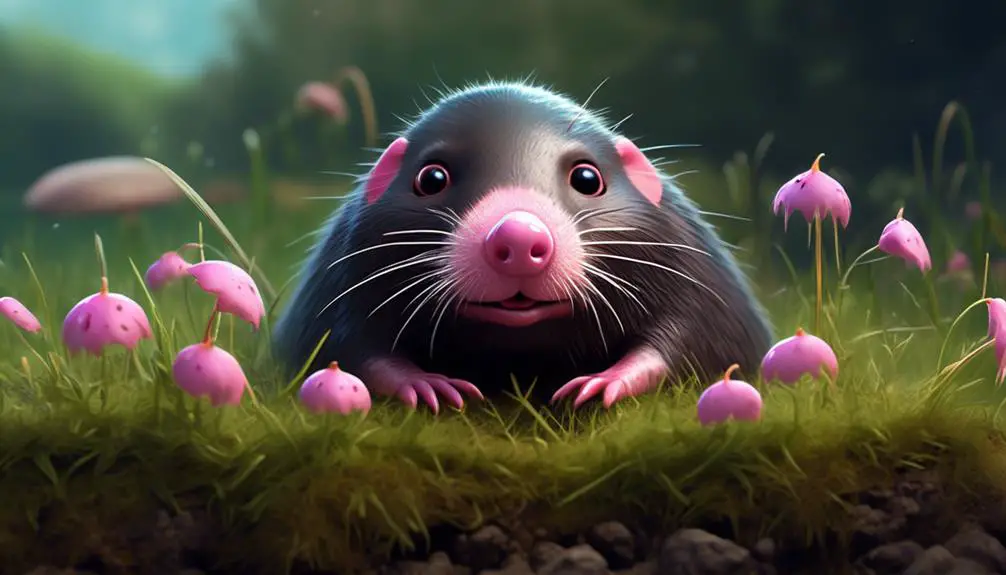
With their poor eyesight but a strong sense of smell, animals such as opossums, skunks, gophers, raccoons, and squirrels rely heavily on their olfactory abilities to locate their preferred food sources, including grubs.
These animals have adapted to compensate for their limited visual acuity by developing an acute sense of smell. Opossums and skunks, for example, dig small holes in soft turf to search for grubs, using their sensitive noses to detect the presence of these underground delicacies.
Gophers, on the other hand, create intricate tunnel systems to locate and feast on grubs near the soil surface. Despite their poor eyesight, raccoons are notorious for their ability to find and ransack lawns in search of grubs, relying heavily on their sense of smell to guide them.
Squirrels, with their exceptional foraging skills, can locate food even beneath a foot of snow, including grubs, thanks to their strong sense of smell.
Tunnels Underground
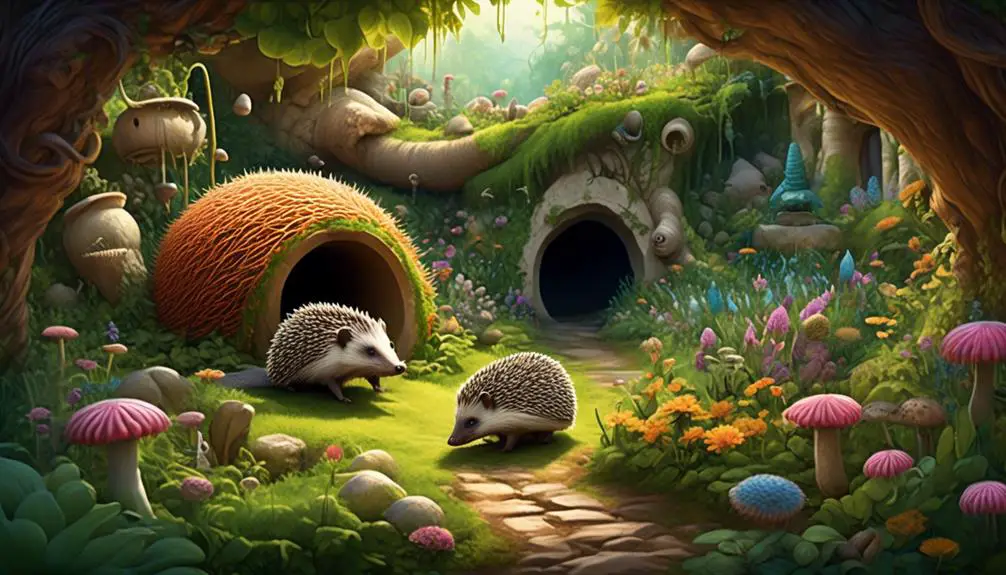
The intricate tunnel systems created by gophers serve as an underground network for locating and accessing their preferred food sources, such as grubs near the soil surface. Gophers are well-known for their ability to dig complex tunnels, which can span over hundreds of feet and reach depths of several feet. These tunnels are carefully constructed, with multiple entrances and exits, allowing gophers to navigate their underground world efficiently.
The main purpose of these tunnels is to provide gophers with easy access to their preferred food sources. Grubs, in particular, are a delicacy for gophers and are often found near the soil surface. By burrowing underground, gophers can quickly locate and consume these grubs, ensuring a steady supply of nutrients.
The tunnels also serve other important functions for gophers. They provide shelter from predators and harsh weather conditions. Gophers create nesting chambers within their tunnels, where they can rest and raise their young in safety. The tunnels also help with the aeration of the soil, promoting healthy plant growth.
Not Too Picky Eaters
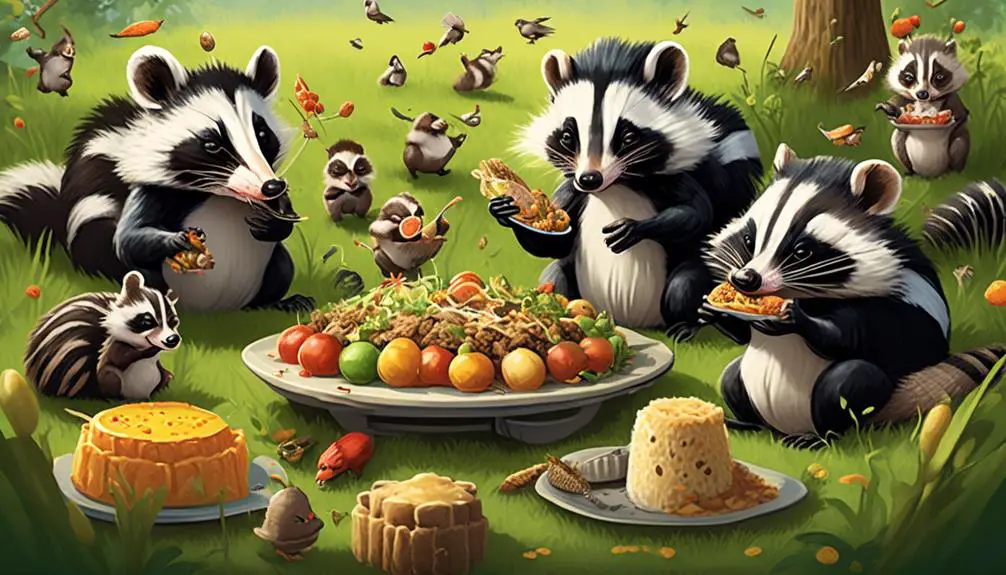
Animals that eat lawn grubs, such as opossums, skunks, gophers, raccoons, and squirrels, aren’t particularly selective when it comes to their food choices. These creatures have adapted to survive by consuming a wide range of food, including grubs.
Opossums, with their delicate feet and nails, may dig small holes in soft turf to search for grubs, but they try to avoid damaging lawns unless desperate.
Skunks, on the other hand, are omnivorous and rely on their sense of smell to find food. They dig holes in the ground to search for earthworms and grubs, which are readily available and provide a delicious meal.
Gophers, known for their tunneling abilities, create underground tunnels to locate and eat their preferred food, including insect grubs. These tunnels provide easy access to grubs near the soil surface, satisfying their not-so-picky appetite.
Raccoons, notorious for causing damage to gardens and lawns, love to eat grubs. They’ll ransack turf to find grubs and keep coming back for more.
Finally, squirrels, resourceful foragers, include grubs in their menu, especially during difficult times. Grubs, with their high protein content, serve as a supplement to their diet. Although not their first choice, squirrels appreciate the nutrition that grubs provide.
Love to Eat Grubs
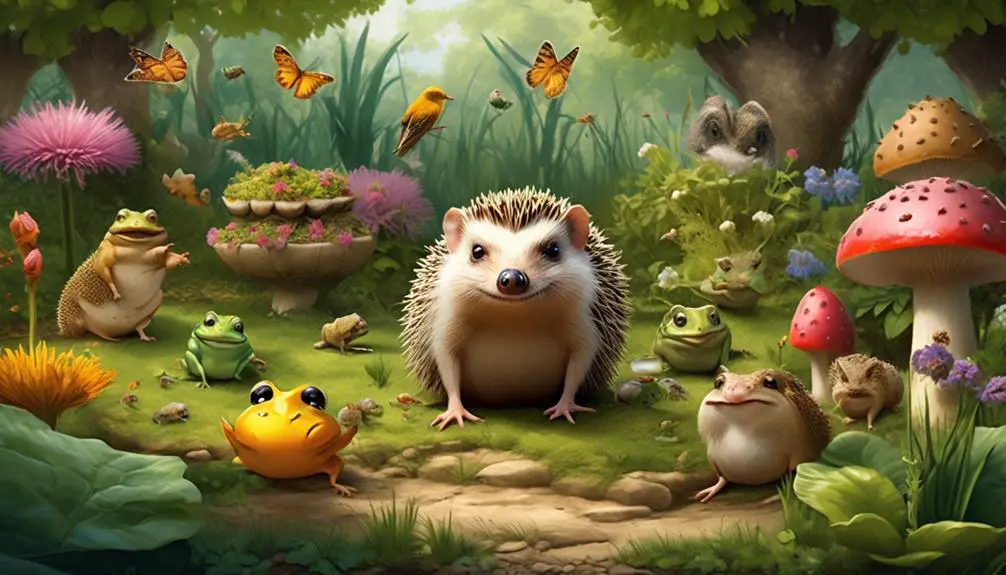
Grub-loving creatures have a strong affinity for these insect larvae due to their nutritional benefits.
Opossums, skunks, gophers, raccoons, and squirrels are among the animals that love to eat grubs. These creatures have different methods of finding and consuming grubs, but they all recognize the value of this tasty food source.
Grub-Loving Creatures
With their delicate feet and nails, opossums and skunks delicately search for grubs in lawns, while gophers create tunnels underground to feast on these delicious morsels. Grub-loving creatures have developed unique strategies to find and consume their favorite food. Let’s take a closer look at their behaviors and feeding habits:
| Creature | Behavior | Feeding Habits |
|---|---|---|
| Opossums | Dig small holes | Search for grubs in soft turf, avoid digging up lawns |
| Skunks | Dig holes in the ground | Rely on sense of smell to find earthworms and grubs |
| Gophers | Create underground tunnels | Locate and eat earthworms and grubs near the soil surface |
| Raccoons | Ransack turf | Search for grubs and return for more |
| Squirrels | Store more food | Include grubs as supplement to their diet |
These animals have evolved to thrive on a diet that includes grubs. By understanding their behaviors, we can better appreciate their role in maintaining ecological balance and managing lawn grubs.
Nutritional Benefits of Grubs
Grubs, with their high protein content and abundant availability, offer a valuable source of nutrition for a variety of creatures in their quest for sustenance. These creatures include opossums, skunks, gophers, raccoons, and squirrels.
The nutritional benefits of grubs are significant, particularly due to their protein content. Protein is essential for the growth, maintenance, and repair of body tissues. Additionally, grubs are rich in other nutrients such as fats and carbohydrates, which provide energy for these animals. Grubs also contain vitamins and minerals that contribute to overall health and well-being.
For animals like opossums, skunks, and raccoons, grubs serve as a delicious and highly preferred food source. Their abundant availability makes them an easily accessible and nutritious meal option.
Can Cause Damage to Gardens and Lawns
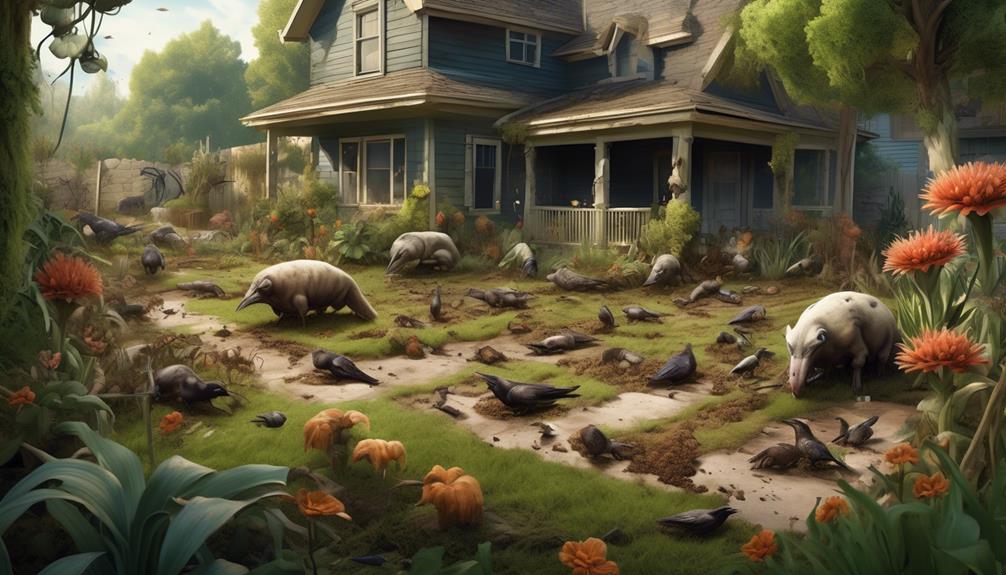
Animals such as opossums, skunks, gophers, raccoons, and squirrels can wreak havoc on gardens and lawns. These creatures can cause damage as they search for and consume grubs, which are a preferred food source for them.
Opossums, with their delicate feet and nails, may dig small holes in soft turf to search for grubs. However, they generally try to avoid digging up lawns for food unless they’re desperate.
Skunks, on the other hand, are omnivorous and have poor eyesight. They rely on their sense of smell to find food, including grubs. Skunks dig holes in the ground to search for earthworms and grubs, potentially causing damage to lawns and gardens.
Gophers, known for their tunneling behavior, create underground tunnels to locate and eat their preferred food, including insect grubs. These tunnels provide easy access to grubs near the soil surface.
Raccoons love to eat grubs and are notorious for ransacking turf to find them. They’ll keep coming back for more if they find a reliable source of grubs.
Squirrels, although not primarily dependent on grubs, include them in their diet, especially during difficult times. Grubs serve as a supplement for squirrels due to their high protein content.
Find Food Even Beneath Snow
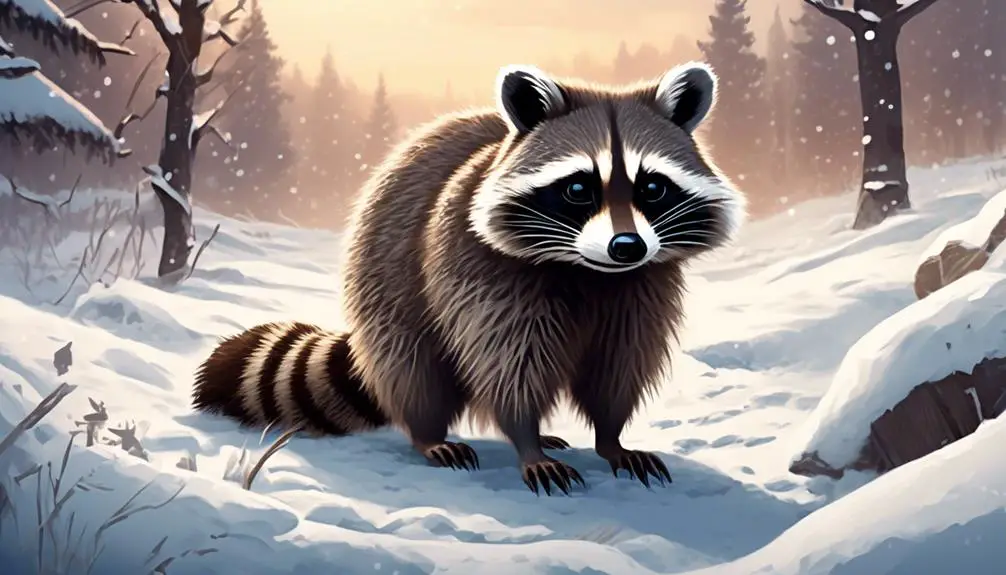
You notice that even when covered in a thick layer of snow, animals like opossums, skunks, gophers, raccoons, and squirrels find a way to locate their food source. Their survival instincts kick in, leading them to search for grubs even beneath the snow.
These animals have developed techniques to navigate through the winter landscape and uncover the nutritious grubs that serve as their sustenance during this challenging time.
Snow Foraging Techniques
Even beneath a foot of snow, squirrels demonstrate their impressive foraging skills by finding food to sustain themselves during the winter months. Despite the challenging conditions, these nimble creatures employ various snow foraging techniques to locate their next meal.
One technique involves using their sharp claws to dig through the snow and uncover hidden food sources. Squirrels are known to have an exceptional memory, allowing them to remember the precise locations where they buried their food caches before the snowfall. They also rely on their keen sense of smell to detect buried nuts or seeds.
Additionally, squirrels are adept at navigating tree branches and can leap from tree to tree, searching for any remaining food sources that may be accessible above the snow.
Through these remarkable abilities and strategies, squirrels are able to survive and thrive even in the harshest winter conditions.
Grubs as Winter Sustenance
During the winter months, squirrels demonstrate their remarkable ability to find sustenance even beneath a foot of snow by relying on their sharp claws, exceptional memory, and keen sense of smell.
Despite the challenges posed by the frozen landscape, squirrels have adapted clever strategies to locate grubs, which serve as a valuable source of nutrition during this time.
With their sharp claws, squirrels are able to dig through the snow and uncover hidden grubs beneath the surface.
Additionally, their exceptional memory allows them to remember the locations where they’ve previously found grubs, increasing their chances of success.
Furthermore, squirrels possess a keen sense of smell, enabling them to detect the presence of grubs even when they’re buried deep beneath the snow.
This combination of physical adaptations and sensory abilities allows squirrels to find sustenance and survive in the winter months.
High Protein Content
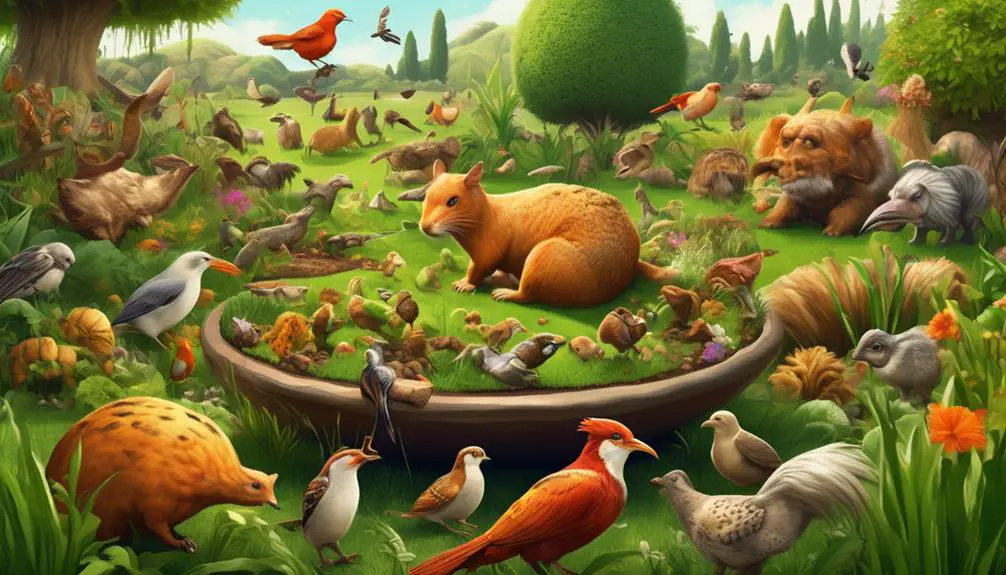
The high protein content of grubs makes them a valuable food source for animals such as opossums, skunks, gophers, raccoons, and squirrels. These animals rely on the protein-rich grubs to meet their nutritional needs. Grubs provide an abundant source of energy and essential amino acids, making them a highly desirable food for these creatures.
To illustrate the importance of high protein content in grubs, let’s take a closer look at the nutritional composition of these larvae compared to other common food sources for these animals:
| Food Source | Protein Content (per 100g) |
|---|---|
| Grubs | 14g |
| Earthworms | 8g |
| Seeds | 2g |
As shown in the table above, grubs contain significantly higher levels of protein compared to earthworms and seeds. This highlights the nutritional advantage that grubs offer to opossums, skunks, gophers, raccoons, and squirrels.
The high protein content in grubs contributes to the overall health and vitality of these animals. Protein is essential for muscle growth, tissue repair, and maintaining a healthy immune system. By consuming grubs, these animals can ensure they have the necessary nutrients to thrive in their respective habitats.

Erzsebet Frey (Eli Frey) is an ecologist and online entrepreneur with a Master of Science in Ecology from the University of Belgrade. Originally from Serbia, she has lived in Sri Lanka since 2017. Eli has worked internationally in countries like Oman, Brazil, Germany, and Sri Lanka. In 2018, she expanded into SEO and blogging, completing courses from UC Davis and Edinburgh. Eli has founded multiple websites focused on biology, ecology, environmental science, sustainable and simple living, and outdoor activities. She enjoys creating nature and simple living videos on YouTube and participates in speleology, diving, and hiking.

